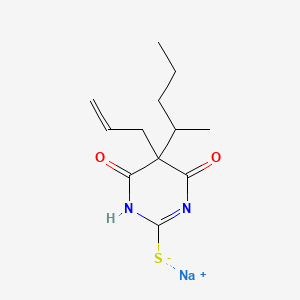



1. Sodium, Thiamylal
2. Surital
3. Thiamylal
4. Thioquinalbarbitone
1. Sodium Thiamylal
2. Thiamylal Sodium Salt
3. 337-47-3
4. Surital Sodium Salt
5. Ncgc00095772-01
6. 5-allyl-5-(1-methylbutyl)-2-thiobarbituric Acid, Sodium Salt
7. Surital Sodium
8. Thiomylal Sodium
9. Sodium 5-allyl-5-(1-methylbutyl)-2-thiobarbiturate
10. Thioseconal Sodium
11. T4l2p3kh7k
12. 5-allyl-5-(1-methylbutyl)-2-thiobarbituric Acid, Sodium Derivative
13. Surital Sodium Deriv.
14. Nsc-759558
15. 4,6-(1h,5h)-pyrimidinedione, Dihydro-5-(1-methylbutyl)-5-(2-propenyl)-2-thioxo-, Monosodium Salt
16. Einecs 206-415-5
17. Unii-t4l2p3kh7k
18. Thiamylal Sodium [usp:jan]
19. Surital (tn)
20. 5-allyl-5-(1-methylbutyl)-2-thiobarbiturate Sodium
21. 5-allyl-5-(1-methylbutyl)-2-thio-barbituric Acid Sodium Salt
22. Thiamylal Sodium (jp17)
23. Dsstox_cid_25988
24. Dsstox_rid_81275
25. Dsstox_gsid_45988
26. Schembl34746
27. Spectrum1900002
28. Chebi:9537
29. Chembl1201065
30. Dtxsid3045988
31. Hms503e21
32. Hms2094g05
33. Tox21_111517
34. Barbituric Acid, 5-allyl-5-(1-methylbutyl)-2-thio-, Sodium Salt
35. Ccg-213640
36. Nsc 759558
37. Ncgc00095772-02
38. 4,6(1h,5h)-pyrimidinedione, Dihydro-5-(1-methylbutyl)-5-(2-propenyl)-2-thioxo-, Monosodium Salt
39. Cas-337-47-3
40. D00713
41. Q27289664
| Molecular Weight | 276.33 g/mol |
|---|---|
| Molecular Formula | C12H17N2NaO2S |
| Hydrogen Bond Donor Count | 1 |
| Hydrogen Bond Acceptor Count | 3 |
| Rotatable Bond Count | 5 |
| Exact Mass | 276.09084324 g/mol |
| Monoisotopic Mass | 276.09084324 g/mol |
| Topological Polar Surface Area | 59.5 Ų |
| Heavy Atom Count | 18 |
| Formal Charge | 0 |
| Complexity | 384 |
| Isotope Atom Count | 0 |
| Defined Atom Stereocenter Count | 0 |
| Undefined Atom Stereocenter Count | 2 |
| Defined Bond Stereocenter Count | 0 |
| Undefined Bond Stereocenter Count | 0 |
| Covalently Bonded Unit Count | 2 |
Anesthetics, Intravenous
Ultrashort-acting anesthetics that are used for induction. Loss of consciousness is rapid and induction is pleasant, but there is no muscle relaxation and reflexes frequently are not reduced adequately. Repeated administration results in accumulation and prolongs the recovery time. Since these agents have little if any analgesic activity, they are seldom used alone except in brief minor procedures. (From AMA Drug Evaluations Annual, 1994, p174) (See all compounds classified as Anesthetics, Intravenous.)
GABA Modulators
Substances that do not act as agonists or antagonists but do affect the GAMMA-AMINOBUTYRIC ACID receptor-ionophore complex. GABA-A receptors (RECEPTORS, GABA-A) appear to have at least three allosteric sites at which modulators act: a site at which BENZODIAZEPINES act by increasing the opening frequency of GAMMA-AMINOBUTYRIC ACID-activated chloride channels; a site at which BARBITURATES act to prolong the duration of channel opening; and a site at which some steroids may act. GENERAL ANESTHETICS probably act at least partly by potentiating GABAergic responses, but they are not included here. (See all compounds classified as GABA Modulators.)
Hypnotics and Sedatives
Drugs used to induce drowsiness or sleep or to reduce psychological excitement or anxiety. (See all compounds classified as Hypnotics and Sedatives.)
